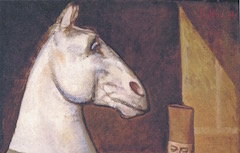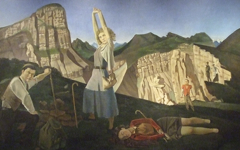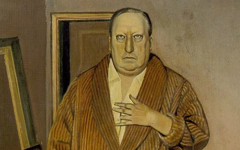Balthus’ The Mountain (1937) Part 1
Both landscapes by Balthus in the collection of The Metropolitan Museum are, nominally speaking, scenes from the Swiss Alps. During summers in his teens Balthus' mother took him there where he soon became an assistant to the Swiss sculptor, Margit Bay. Bay was a member of an arts-and-crafts group with anthroposophical leanings and one of Balthus' first commissions was to paint an altarpiece and ceiling decoration for Bay's anthroposophical Chapel. A surviving photograph bears witness to the room but the works are lost. Balthus was also "adopted" as a teen by the esoteric poet, Rainer Maria Rilke, who was greatly impressed by him and had a romantic interest in his mother.1 Thus Balthus would have soaked up a lot about the Inner Tradition from either connection and learnt about the spiritual objectives common to its many different disciplines, from Gnosticism and Neoplatonism to Theosophy and Buddhism.
With that in mind, Balthus' 1935 landscape Summertime is unlikely to be a simple representation of the Swiss Alps. Inspired by Poussin's Echo and Narcissus, which he had copied, Balthus re-dressed Narcissus in modern clothes and placed him as a woman in the foreground, an androgynous representation of his own creativity. Narcissus was said in the Renaissance to have been the legendary inventor of Painting, a powerful symbol for artists who reflected their own image in art.
Click next thumbnail to continue
Two year later Balthus reconstructed Summertime and turned it into his masterpiece,The Mountain. Sabine Rewald who visited the area remarked that: "The mountainscape [by Balthus] is composed of real, though transformed, elements as well as invented ones. All the mountains can be identified." She added that here Balthus continued his homage to Poussin "emulating Poussin's famous allegorical landscape cycle..." 2
Click next thumbnail to continue

Top L&R: Detail of Balthus' The Mountain; Detail of Poussin's Self-Portrait
Bottom L&R: Diagram of Balthus' The Mountain; Detail of Poussin's Self-Portrait
Click image to enlarge.
What Rewald did not recognize is that the contour of the mountain-tops is also based on Poussin's head. That can hardly be coincidence. See how his hairline matches the contour of rock and grass. The pile of rocks on the left marks one eye while the dark shadow of a tourist's skirt signals part of the other eye. His "nose" rises up through his "forehead" but is still recognizable. Even the parting in Poussin's hair can be seen where two rock-faces meet. A diagram indicating the various features is at left on the lower level.
Click next thumbnail to continue

Left: Diagram of Balthus' The Mountain
Right: Detail of Poussin's Self-Portrait, inverted
Click image to enlarge.
Balthus clearly intended these shapes because the mountain "in profile" on the left appears based on the celebrated personification of Painting in profile behind Poussin in the same self-portrait. The nose, though similar, is at a different angle.
Click next thumbnail to continue
Balthus, in turning the mountain into a representation of Poussin depicts a scene of creativity in his own fertile brain. Rewald, though, has noted that Courbet is a source too because the pipe-smoker resembles one of his stone-breakers.3 And EPPH has shown how Courbet like Balthus used anthropomorphic features of rocks and mountains to form hidden figures. One work is even titled Landscape with Anthropomorphic Rocks.
See conclusion below
There are more landscapes that turn out to be similarly anthropomorphic, by Leonardo, Rembrandt, Poussin, Monet, Renoir and Van Gogh. Take a look at the landscape in Poussin's The Ordination which EPPH revealed is really the face of Christ. It is an even more stunning illusion than Balthus' and may have inspired him. For more surprises within Balthus' masterpiece, see the second part of Balthus' The Mountain.
More Works by Balthus
If it looks odd, there must be a reason. See Balthus horsing around.

Balthus’ The Moroccan Rider with His Horse (1935)
Notes:
1. Sabine Rewald, "Balthus' Magic Mountain", Burlington 137, Sept. 1997, pp. 622-5
2. The cycle is known as The Four Seasons. See ibid., p. 626. Also, Balthus might well have known that at least one of Poussin's landscapes in his 12 Sacraments series is, when turned through 90°, a convincing profile of Christ's head. See Poussin's Ordination (1640's).
3. Rewald also explained that the whole composition is partly indebted to Courbet's Young Ladies from the Village, also in the Metropolitan's collection. Rewald, ibid., pp. 626-7
Original Publication Date on EPPH: 23 Mar 2011. | Updated: 0. © Simon Abrahams. Articles on this site are the copyright of Simon Abrahams. To use copyrighted material in print or other media for purposes beyond 'fair use', you must obtain permission from the copyright owner. Websites may link to this page without permission (please do) but may not reproduce the material on their own site without crediting Simon Abrahams and EPPH.





